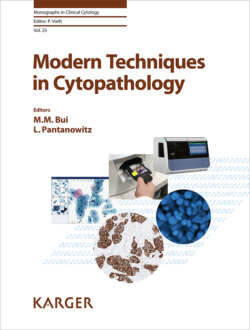Читать книгу Modern Techniques in Cytopathology - Группа авторов - Страница 26
На сайте Литреса книга снята с продажи.
Cell Blocks: Cellularity
ОглавлениеA survey across various cell block-processing methods demonstrated that 44% of respondents were either unsatisfied or sometimes satisfied with the quality of cell blocks, with low cellularity cited as the main reason for disapproval [7]. In a comparison of two common methods, plasma-thrombin and HistoGel, respondents in a survey reported greater satisfaction with use of the former, although the difference was not statistically significant.
Low cellularity may be secondary to multiple factors. Some of the reasons may reflect operator skill, nature of the specimen (e.g., spindle cell, sclerotic, or necrotic samples) or scant available cells/volume of available specimen (e.g., minimal exfoliative fluid with very few cells), while others may reflect cytology-related variables. For instance, low cellularity in a cell block may result from poor triage due to smearing most of the specimen on a slide rather than allocating it for a cell block [23]. Additionally, technical expertise and familiarity with processing cell blocks using one of the traditional methods may be a factor. Knowing the optimal amount of congealing agent to add to the cell pellet is significant; an excess will cause specimen dilution and an insufficient amount will result in suboptimal cohesion and cell loss (Fig. 7).
Whether CACBS cell blocks increase cellularity has not been established. When comparing CACBS with agar, Kruger et al. [24] described a significant improvement in cellularity with the former. This was attributed to the ability of CACBS to confine the cells to a defined area and eliminate dilution with a congealing agent. This is best exemplified in low-cellularity specimens, such as FNA biopsies of the breast [25], vitreous [26], and thyroid [27]. In a study of thyroid FNAs, the addition of a CACBS block to a ThinPrep slide resulted in a change from non-diagnostic to diagnostic in 31% of cases [27]. Meanwhile, others have noted no appreciable improvement in cellularity between traditional-type cell blocks and CACBS [28–30]. CACBS may prove more valuable for very scant specimens rather than cellular ones, as the latter are likely to produce diagnostic cell blocks even with less than optimal methods.
